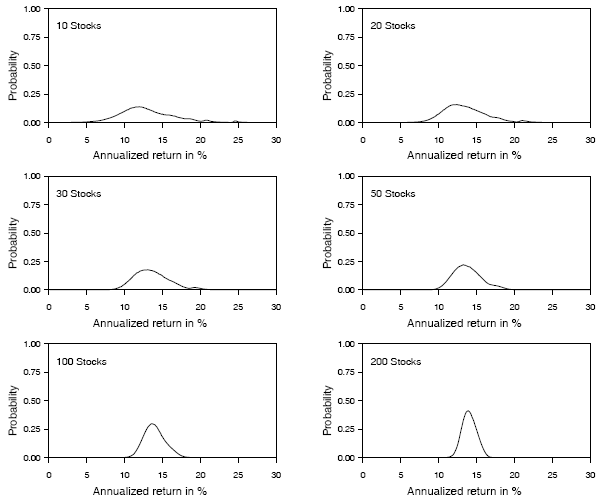How many stocks are enough for the long-term investor to diversify stock-picking risks? Conventional wisdom says that 8 to 20 stocks are enough. In their recent paper entitled “Diversification in Portfolios of Individual Stocks: 100 Stocks Are Not Enough”, Dale Domian, David Louton and Marie Racine examine the risk that long-term buy-and-hold stock portfolios will fall short of some minimum return goal. They use portfolios of different sizes constructed from a real sample of 1,000 U.S. stocks (the 100 largest by market capitalization in each of 10 industries) over the 20-year period from January 1985 through December 2004, inserting comparable replacements for the hundreds of delistings that occur in the sample (mostly due to mergers). They find that:
- About one-fourth of the stocks in the list produces negative annualized returns for the entire period.
- The probability of extreme portfolio underperformance decreases dramatically with portfolio size, even beyond 100 stocks.
- On an end-wealth basis, 40.2% of the 10-stock, 29.2% of the 20-stock, 22.1% of the 30-stock, 13.4% of the 50-stock, 4.3% of the 100-stock and just 0.4% of the 200-stock portfolios underperform the 20-year Treasury bond. A portfolio must have at least 164 stocks to keep the probability of underperforming bonds below 1%.
- Diversification across industries slightly reduces risk for small portfolios, but modestly increasing the number of stocks held is easier.
- Annual rebalancing enhances returns compared to 20-year buy-and-hold, but the enhancement might not exceed taxes and transaction costs.
- Repeating the analysis for the period 1965-1984 reinforces the conclusion that effective diversification requires more than 100 stocks.
The following figures, taken from the paper, show the distribution of returns for all possible portfolios with 10, 20, 30, 50, 100 and 200 stocks. It shows that the distribution sharpens around the mean return, thereby reducing the probability of extreme underperformance, as the number of stocks in the portfolios increases from 10 to 200. Even the additional diversification from 100 stocks to 200 stocks has a visible effect. In other words, the more diversified your portfolio, the less jeopardy for your retirement.

The authors note that mutual funds and exchange-traded funds designed to track broad market indexes are an easy way to achieve the suggested level of diversification.
In summary, diversification produces “peak” performance by collapsing the probability of performance around the mean. With it, you will seldom fly high, or crash and burn.
In general, the stronger one’s belief in efficient markets, the more important diversification becomes as a means to manage (negative) random fluctuations in asset values. Diversification is the tool of the tortoise for a sure finish. The (over?)confident hare, on the other hand, believes in the discovery of a relatively few greatly undervalued assets.